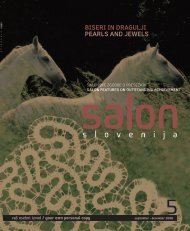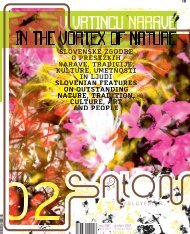energiJa Vode the energY of Water - Salon Slovenija
energiJa Vode the energY of Water - Salon Slovenija
energiJa Vode the energY of Water - Salon Slovenija
You also want an ePaper? Increase the reach of your titles
YUMPU automatically turns print PDFs into web optimized ePapers that Google loves.
62 63<br />
tradicionalno/traditional<br />
Marjeta privšek arhiv / archive TiC Veržej, arhiv / archive inter-m Melinci<br />
reKa in<br />
lJudJe<br />
Plavajoči mlini na Muri<br />
<strong>the</strong> river<br />
and itS<br />
PeoPle<br />
Floating Mills on <strong>the</strong> Mura<br />
po zasanjani ravnici pomurja, pokrajine<br />
na skrajnem severovzhodu Slovenije,<br />
ubira svojo pot reka Mura. V avstriji<br />
izvira kot gorska reka, a se kmalu razlije<br />
po ravnini in skozi Slovenijo, hrvaško in<br />
Madžarsko odvijuga kot počasna nižinska<br />
reka, dokler se ne združi z reko dravo na<br />
skupni poti proti donavi in Črnemu morju.<br />
Mura neprestano spreminja svojo strugo, se cepi v rečne rokave,<br />
dela mrtvice, poplavlja gozdove in s tem ustvarja eksplozijo<br />
neštetih oblik življenja – naš najbogatejši ekosistem, loko. Je<br />
edina večja slovenska reka, ki ji zaenkrat na svojih bregovih še<br />
uspeva ohranjati naravno dinamiko.<br />
Še nedolgo nazaj je ljudem predstavljala nepredvidljivo naravno<br />
silo, ki so jo spoštovali in se je bali. ko je poplavljala, je s seboj<br />
odnašala vse, kar ji je stopilo na pot: brodove, mline, hrano,<br />
življenja … prebivalci ob Muri so trepetali pred mogočnim<br />
nadnaravnim bitjem, Murskim duhom, a so znali živeti z reko,<br />
se ji prilagoditi in se z njo spoprijeti v boju za zemljo. z dolgimi<br />
The dreamy plain <strong>of</strong> pomurje gets its name<br />
from <strong>the</strong> river Mura, which slowly makes<br />
its way across <strong>the</strong> north-eastern corner <strong>of</strong><br />
Slovenia. The Mura originates in austrian<br />
alps, however, on reaching <strong>the</strong> plain it soon<br />
slackens its pace, meandering leisurely<br />
through Slovenia, Croatia and hungary as a<br />
placid lowland river, before joining forces with<br />
<strong>the</strong> drava on <strong>the</strong>ir way towards <strong>the</strong> danube<br />
and <strong>the</strong> black Sea.<br />
The Mura keeps changing its channel, splitting into river branches, creating<br />
stagnant waterholes, flooding woodlands and causing a veritable explosion<br />
<strong>of</strong> countless life forms in <strong>the</strong> process, <strong>the</strong>reby producing <strong>the</strong> richest<br />
ecosystem in existence in Slovenia. it is <strong>the</strong> only major Slovenian river<br />
whose banks continue to maintain <strong>the</strong>ir natural dynamics.<br />
even recently <strong>the</strong> Mura was perceived by <strong>the</strong> people as an unpredictable,<br />
terrifying force <strong>of</strong> nature, which commanded both fear and respect.<br />
When flooding, it would take everything that would inadvertently get in<br />
babičev mlin, Veržej/Babič’s mill veržej<br />
snopi vej in kamenjem so utrjevali bregove, temu so rekli büjranje,<br />
junakom, ki so opravljali to nevarno in težko delo, pa büjraši. pred<br />
desetletji so büjraše zamenjali traktorji in bagri, ki so z modernim<br />
načinom regulacije reke začeli vztrajno spreminjati dotedanji<br />
način življenja reke, bregov in ljudi.<br />
Plavajoči mlini, posebnost panonske pokrajine<br />
Mura že dolga stoletja pozna plavajoče mline, mogočne<br />
konstrukcije z mlinskim kolesom med dvema velikima čolnoma,<br />
s klini in jeklenimi vrvmi vpete na obrežje. S takimi mlini ljudje<br />
niso posegali v tok reke, le spremljali so ga in se mu prilagajali.<br />
ko je reka narasla in poplavljala, se je z gladino vred dvignilo tudi<br />
mlinsko kolo, ki bi ga sicer voda preplavila ali odnesla.<br />
Še na začetku 20. stoletja je po nekaterih podatkih na Muri<br />
mlelo žito več kot sto mlinov. do današnjih dni je preživel le eden,<br />
babičev mlin v Veržeju, ki je zaščiten kot dragocena tehniška<br />
dediščina. Mlinarska hiša na obrežju, povezana s pogonskim<br />
kolesom na dveh čolnih, prijazno odpira vrata obiskovalcem vse<br />
dni v tednu.<br />
its path: boats, mills, supplies, lives… The people along <strong>the</strong> river<br />
lived in constant trepidation <strong>of</strong> <strong>the</strong> mighty supernatural being, <strong>the</strong><br />
Spirit <strong>of</strong> Mura, however <strong>the</strong>y also knew how to get along with <strong>the</strong><br />
river, adjust to its ways and fight it for land. rocks and long stacks <strong>of</strong><br />
branches were typically used to fortify <strong>the</strong> riverbanks; this was called<br />
“bürjanje” while <strong>the</strong> men performing this hard and dangerous job<br />
were called “bürjaši”. it has now been several decades since bürjaši<br />
were replaced by tractors and excavators as modern river regulation<br />
initiated a slow but relentless process <strong>of</strong> change, steadily eroding<br />
<strong>the</strong> old ways <strong>of</strong> <strong>the</strong> river, its banks and <strong>the</strong> people.<br />
floating mills, a distinctive feature <strong>of</strong> <strong>the</strong> Panonian plain<br />
people have been building floating mills on <strong>the</strong> Mura for many<br />
centuries. essentially, a floating mill is a heavy-duty structure<br />
featuring a mill wheel between two large boats, anchored to <strong>the</strong><br />
riverbank by means <strong>of</strong> steel pegs and ropes. This way, it did not<br />
interfere with <strong>the</strong> course <strong>of</strong> <strong>the</strong> river but simply went with <strong>the</strong> flow.<br />
as <strong>the</strong> river swelled and flooded, <strong>the</strong> mill wheel would simply rise<br />
with <strong>the</strong> water instead <strong>of</strong> being submerged or swept away.<br />
according to some sources, over one hundred floating mills on <strong>the</strong><br />
Mura were still used to grind grain at <strong>the</strong> turn <strong>of</strong> <strong>the</strong> 20th century.<br />
however, only one has survived to <strong>the</strong> present day: babič’s mill







